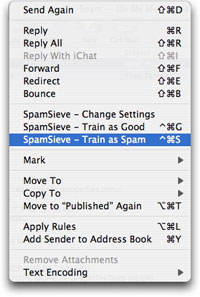

A new Act-On rule lets you mark messages as junk or not junk.

This significantly reduces clutter.Īnother new feature is that you can now forward messages as an attachment instead of an inline message - no more endless threads in one huge message, potentially clogging up your receiver’s mail client. If you have made such rules, there’s now a checkbox that allows you to hide those rules when messages don’t have those characteristics. it works only on messages with specific characteristics. Suppose you have an Act-On rule that is conditional, i.e. That way, it’s better to understand which messages you are “acting” on. For starters, it has a redesigned menu window that sticks to the message viewer. Mail Act-On 4, however, is a different matter. MailTags 5 has only been updated to be compatible with Sierra. If you work with VIP statuses, this enables you to have the VIP folder’s content visible at all times, next to, the folder that contains messages from less important people you can’t ignore nevertheless, for example. The clever thing about Mail Perspectives is that you can choose to show only today’s messages, new messages or all of the folder’s content. In contrast, Mail Perspectives allows you to create one window with any number of folders listing their content. However, it still requires you to go into that smart folder. For some time now, Mail has gained the ability to create a VIP system that allows you to group the messages from people you deem important. The predecessors of SmallCubed released Mail Perspectives a good number of years ago and it still is one of the best ways to focus on the important email folders in Apple Mail. For the first time, I’ve also tried out the SigPro plug-in. I have been reviewing the MailTags, Mail Act-On and Mail Perspectives suite for quite some time now.

Spamsieve memory full#
I can definitely shut down iTunes when I'm not actively listening to music since it's just a slow system hog even when nothing else is running.SmallCubed released its full set of Apple Mail plug-ins right in time for the release of macOS “Sierra”. But perhaps I need to suspend it to stop it from consuming CPU cycles and memory and just take the hit on the start up time to resume the VM? But that's dozens of times a day though so I don't know.
Spamsieve memory windows 10#
I try to pause Parallels whenever I'm not actively doing something in Windows 10 since that stops it from consuming CPU cycles and click brings it back instantly.
Spamsieve memory mac#
But I'm one of two Mac users at my company so I don't know how many apps the typical Mac user runs simultaneously. I'm not doing any coding or photo/video editing so I just don't need the raw horsepower of a MacBook Pro. And naturally the same applies to travel. I think I prefer the 12 inch MacBook because I'm always going from meeting to meeting at work so the lighter the better. Looks like I was barking up the wrong tree. I tried that and Mail wasn't slow at all. am I running into the limitations of the Mail app with this volume of email? Or is the sluggishness I'm experiencing more related to running Parallels, MS Teams, iTunes, Safari, Activity Monitor, etc all at the same time? I only wonder about the Mail app because in Activity Monitor the processes that consume the most memory are Parallels, WindowServer, and kernel_task always.
Spamsieve memory archive#
The thought of going through years of emails to find and archive important things or just delete all the spam is daunting at best and terrifying at worst. sometimes when it comes to UI responsiveness. I just know that Mail feels "sluggish" at times. I don't know if that is considered "high" or not. I notice when I fire up the Mail app it will consume anywhere from 400-700 MB of memory as reported by Activity Monitor. I have a 2017 MacBook with 512 GB of storage and 8 GB of RAM. Everything else lives in my "Inbox" or my "Sent" folder and I just use search or flags to find things. Except for emails I'm positive are election cycle begging and I have a rule set up to automatically move it to a "Political" folder so I never have to see it. So this is where I stand now with respect to storage. All the way back to Yahoo and Mindspring email accounts. My personal emails in iCloud go back to April 1999. My work emails in Exchange go back to Feb.


 0 kommentar(er)
0 kommentar(er)
